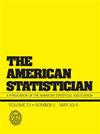使用mgcv计数数据的灵活分布式滞后模型
IF 2.1
4区 数学
Q1 STATISTICS & PROBABILITY
引用次数: 0
摘要
在本教程中,我们介绍了使用R包mgcv以灵活的方式实现分布式滞后非线性模型(dlnm)。将平滑样条解释为随机量可以实现近似贝叶斯推理,从而允许不确定性量化和全面的模型检查。我们使用开放获取的流行病学数据结合模拟实验说明了各种建模情况。我们展示了时间结构的包含和混合分布的使用,以允许极端异常值。此外,我们证明了时间滞后结构与其他协变量的相互作用,不同的协变量具有不同的滞后周期。还演示了空间结构,包括平滑空间变异性和马尔可夫随机场,以及允许非结构化依赖的分层公式。后验预测仿真用于确保模型与数据的良好验证。本文章由计算机程序翻译,如有差异,请以英文原文为准。
Flexible distributed lag models for count data using mgcv
In this tutorial we present the use of R package mgcv to implement Distributed Lag Non-Linear Models (DLNMs) in a flexible way. Interpretation of smoothing splines as random quantities enables approximate Bayesian inference, which in turn allows uncertainty quantification and comprehensive model checking. We illustrate various modeling situations using open-access epidemiological data in conjunction with simulation experiments. We demonstrate the inclusion of temporal structures and the use of mixture distributions to allow for extreme outliers. Moreover, we demonstrate interactions of the temporal lagged structures with other covariates with different lagged periods for different covariates. Spatial structures are also demonstrated, including smooth spatial variability and Markov random fields, in addition to hierarchical formulations to allow for non-structured dependency. Posterior predictive simulation is used to ensure models verify well against the data.
求助全文
通过发布文献求助,成功后即可免费获取论文全文。
去求助
来源期刊

American Statistician
数学-统计学与概率论
CiteScore
3.50
自引率
5.60%
发文量
64
审稿时长
>12 weeks
期刊介绍:
Are you looking for general-interest articles about current national and international statistical problems and programs; interesting and fun articles of a general nature about statistics and its applications; or the teaching of statistics? Then you are looking for The American Statistician (TAS), published quarterly by the American Statistical Association. TAS contains timely articles organized into the following sections: Statistical Practice, General, Teacher''s Corner, History Corner, Interdisciplinary, Statistical Computing and Graphics, Reviews of Books and Teaching Materials, and Letters to the Editor.
 求助内容:
求助内容: 应助结果提醒方式:
应助结果提醒方式:


